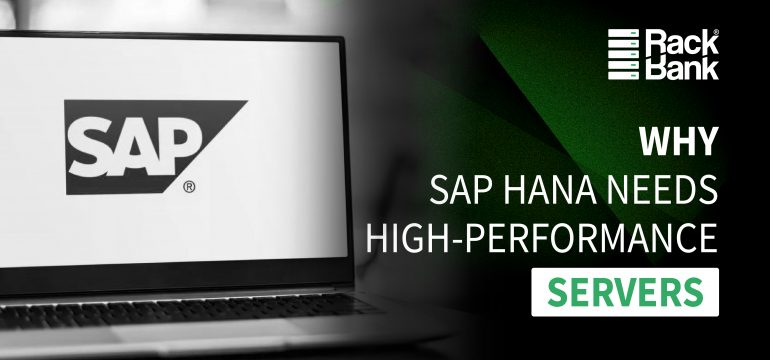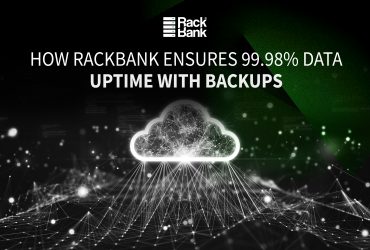Introduction
As data volumes soar in a hyperconnected digital world, organizations across India are turning to SAP HANA for real-time analytics and business intelligence. But the power of SAP HANA can only be harnessed with robust, high-performance servers and a resilient enterprise server infrastructure. At RackBank, India’s premier data center, we understand the crucial role hardware plays in SAP HANA hosting, optimizing mission-critical workloads and delivering next-gen solutions for the modern enterprise.
This comprehensive blog explores in detail:
- The core architecture of SAP HANA
- Why high-performance servers are indispensable
- Key considerations in server selection and deployment
- A guide to SAP HANA server configuration
- On-premise vs cloud choices
- Capacity planning and cost-effective deployment
- Real-world best practices and recommended specs
- How to optimize SAP application performance at scale
SAP HANA: The Power of In-Memory Computing
What is SAP HANA?
SAP HANA (High-performance Analytic Appliance) is an advanced, in-memory database and platform that empowers businesses to analyze massive volumes of transactional and analytical data in real time. Its unique combination of in-memory computing, columnar database structures, and massively parallel processing makes it the bedrock for intelligent enterprises.
The Shift to In-Memory Computing for SAP
Traditional disk-based databases are ill-equipped for today’s rapid-fire decision-making environments. In-memory computing for SAP leverages RAM to store entire datasets, bypassing the latency of hard disk reads and writes. The result: query responses and analytics that are orders of magnitude faster.
- Disk-based read time: ~5 milliseconds
- SAP HANA in-memory read time: ~5 nanoseconds
This million-fold speedup enables real-time dashboards, instant reporting, and business agility.
Why Does SAP HANA Require High-Performance Servers?
Architectural Demands
SAP HANA’s hardware-intensive architecture is designed to exploit the full potential of modern, high-throughput hardware. It stores all operational data in the system’s memory (RAM), using multicore CPUs and parallelism for computation. For this reason, sub-par hardware directly undermines performance, reliability, and scalability.
Key Engineering Reasons:
- Data volume in RAM: Large memory footprints require high-density, error-correcting RAM modules.
- Massive parallelism: Powerful multi-core CPUs and fast interconnects.
- High-speed I/O: NVMe SSDs or enterprise SAN integration for backup and persistence.
- Networking: Ultra-fast (10Gbps, 25Gbps, or higher) network interfaces for clustering and failover.
Failing to meet these hardware demands leads to bottlenecks, system instability, poor user experience, and increased downtime for mission-critical applications.
SAP HANA Hardware Architecture
Core SAP HANA Server Components
| Component | Functionality |
| Index Server | Stores data, handles queries, manages transactions and data engines |
| Name Server | Maintains topology and metadata for distributed setups |
| Preprocessor | Handles text analysis, search |
| XS Engine | Connects to web applications |
| Statistics Server | Collects system performance data |
The “heart” of the system is the Index Server, where all SQL and calculation logic is executed in-memory. For high availability, clustering and redundancy across multiple servers are common.
SAP HANA Appliance Approach
SAP HANA is typically delivered as a pre-configured appliance a tight integration of software and hardware certified by SAP and built by vendors such as Lenovo, Dell, HPE, Cisco, and others.
The Role of High-Performance Servers
Key Performance Drivers
- High-speed memory (RAM): Directly determines how much data and how many applications can be held and computed in-memory.
- Modern, multi-core CPUs: Critical for maximizing the parallelism inherent in HANA’s calculation engines.
- Fast storage systems: For non-volatile log and backup operations. SSD/NVMe is strongly recommended.
- Enterprise-grade motherboards and interconnects: Stay compatible with next-gen RAM and CPU modules.
High-Speed Servers = Superior SAP HANA System Performance
“SAP HANA reads memory in nanoseconds, more than a million times faster than from traditional disks, but this is only possible if the underlying hardware is enterprise-grade and designed for in-memory computing.”
SAP Infrastructure Optimization
High-performance servers are not just about raw speed but also about SAP infrastructure optimization: resilience, scalability for future growth, and reliability under heavy or unpredictable loads. These are vital for mission-critical SAP workloads, such as enterprise resource planning (ERP), supply chain, and real-time analytics.
Server Specification: SAP HANA Compatibility and Certification
Recommended Server Specs for SAP HANA
| Requirement | Recommended Spec (Minimum) |
| CPU | Intel Xeon E7 v3 or later; AMD EPYC equivalent. Up to 40 cores |
| RAM | From 256GB (small) up to 24TB+ (for large deployments) |
| Network | 10Gbps (minimum), ideally 25Gbps or more |
| Storage | Enterprise SSD/NVMe; RAID protected; high IOPS |
| OS | SUSE Linux SLES, Red Hat Enterprise Linux for SAP |
| Redundancy | Dual power, RAID, ECC memory, hot-swap drives |
SAP regularly publishes a Hardware Certification List, and deployment must always use SAP HANA certified hardware for full support and best performance.
Scalable Server Infrastructure for SAP HANA
Capacity Planning and Scaling
Capacity planning for SAP HANA servers is not a one-size-fits-all approach. Key variables include data growth rate, number of users, transaction volume, analytics requirements, and projected business expansion. There are two main scaling strategies:
- Scale-up: Adding more CPU and RAM to an existing server. Ideal for moderate, predictable growth.
- Scale-out: Linking multiple servers (nodes) to form a single logical database instance. Supports massive datasets and geodistributed workloads.
Server Capacity Planning Checklist
- Determine total database size and transaction demand
- Factor in future business growth (at least 3-5 years)
- Size for peak load; add overhead for in-memory processing
- Choose modular, expandable systems that support hot-swapping CPUs, RAM, and storage
Graph: Memory, CPU, and Performance Relationship in SAP HANA Servers
Below is a conceptual illustration of how adding more memory and CPU cores increases SAP HANA system performance, up to hardware and software-defined limits. Note that performance grows linearly only up to a point before it plateaus due to architectural constraints.
On-Premise vs Cloud SAP HANA: Which Hosting Model Fits?
On-Premise Deployments
- Pros: Full control, maximum security, regulatory compliance, ideal for legacy integration and customization.
- Cons: Higher upfront capex, ongoing hardware refresh, in-house IT management required.
Cloud Deployments
- Pros: Flexible, scalable, rapid deployment, operational expenditure model, managed services available.
- Cons: Potential regulatory and data residency issues, long-term costs can rise, shared tenancies may not support extreme customization.
Hybrid SAP HANA Data Center Solutions
A hybrid model, increasingly popular, keeps mission-critical data and workloads on-premises, while leveraging cloud for elasticity, disaster recovery, or non-core analytics workloads.
SAP HANA Server Solutions and Hosting in India
Providers such as RackBank, along with major OEMs, offer dedicated SAP HANA hosting tailored for Indian enterprises, factoring in local compliance, data sovereignty, and low-latency access.
Cost-Effective High-Performance Servers for SAP Workloads
Balancing Performance and Cost
While high-performance servers are critical, cost always matters. Key best practices include:
- Use SAP certified refurbished hardware for secondary and non-mission workloads.
- Opt for modular server platforms to scale RAM/CPU as your needs grow.
- Leverage managed hosting providers in India like RackBank for OPEX-based services.
Cost vs. Performance Considerations
| Factor | On-Premise | Managed Hosting/Cloud |
| Upfront Hardware Cost | High | Low (Pay as you grow) |
| Performance Tuning Flexibility | Maximum | Moderate-High |
| Vendor Support | Varies | 24×7 and highly specialized |
| Scalability | Needs manual addition | Instantly scalable |
| Downtime/SLAs | IT managed | Provider-managed (up to 99.99%) |
SAP HANA Server Configuration & Optimization: Real-World Guide
SAP HANA Server Configuration Guide
- Follow SAP’s Hardware Directory: Only deploy SAP HANA on SAP-certified appliances.
- Balance CPU and Memory: Observe a 1:8 CPU:GB RAM ratio or as per SAP sizing recommendations.
- Consider Workload Type: OLAP-oriented leads to higher RAM needs; OLTP balanced between CPU and RAM.
- Integrate Fast Storage: For log and backup, NVMe or enterprise SSD with RAID.
- Multiple Network Interface Cards (NICs): For parallel traffic, redundancy, and clustering efficiency.
- Data Backups: Regular, automated, non-disruptive.
SAP HANA Performance Tuning with Hardware
- Upgrade to the fastest available RAM.
- Migrate to next-gen CPUs as application load increases.
- Use parallel NVMe arrays to eliminate write I/O bottlenecks.
- Monitor and re-tune buffer and cache allocation regularly.
How to Choose the Right Hosting Environment for SAP HANA
Key Factors
- Workload criticality: Mission-critical = dedicated hardware or on-premise private cloud.
- Growth projections: Rapid business growth favors cloud or scalable infrastructure.
- Compliance and security: Regulated industries may require on-premise or hybrid.
- Support and management: In-house IT vs. managed services provider.
Checklist
- Confirm the server meets the latest SAP-certified hardware specs.
- Ensure hosting partner offers SLAs aligned to your business risk profile.
- Choose a provider with SAP expertise and 24×7 technical support for SAP HANA environments.
Conclusion: Investing in High-Performance Servers Is Non-Negotiable for SAP HANA Success
SAP HANA delivers transformational value only when backed by the right high-performance servers, engineered for in-memory workloads, and designed for scalability, resilience, and cost-efficiency.
In summary:
- High-speed, enterprise-grade servers are essential not optional for SAP HANA.
- Investing in the best servers for SAP HANA ensures uninterrupted SAP application performance, future-proofs your IT, and massively boosts agility.
- Capacity planning and configuration are strategic, not tactical, ensuring enterprise success both today and as your data grows.
- Leaders like RackBank provide trusted, optimized SAP HANA server solutions tailored to India’s unique requirements.
Future-proof your business with the right SAP HANA infrastructure and unleash your data’s full potential.


Leave a Reply
You must be logged in to post a comment.